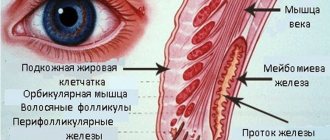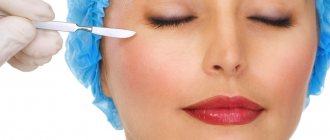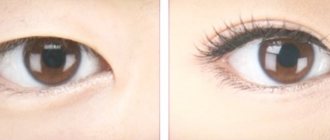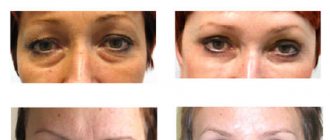PROMOTION
Until October 31, 2020, the CONSTANTA Clinic has a special offer:
Blepharoplasty (upper or lower) under local anesthesia – 40,000 rubles. All inclusive!
*When performing upper or lower blepharoplasty by plastic surgeons Pshenisnova E.S., Ph.D. Kashmanov A.E., Doctor of Medical Sciences, Professor Bessonov S.N. the cost of the special offer is 55,000 rubles.
Blepharoplasty (upper and lower) under local anesthesia – RUB 50,000. All inclusive!
*When performing upper and lower blepharoplasty under local anesthesia by plastic surgeons Pshenisnova E.S., Ph.D. Kashmanov A.E., Doctor of Medical Sciences, Professor Bessonov S.N. the cost of the special offer is 65,000 rubles.
Blepharoplasty (upper and lower) under anesthesia – 65,000 rubles. All inclusive!
*When performing upper and lower blepharoplasty under general anesthesia by plastic surgeons Pshenisnova E.S., Ph.D. Kashmanov A.E., Doctor of Medical Sciences, Professor Bessonov S.N. the cost of the special offer is 80,000 rubles.
The discount is provided to all patients of the CONSTANTA Clinic in Yaroslavl who received a consultation and a documentary calculation of the cost of the operation before September 31, 2020. The calculation of the cost of the operation is valid for 30 days. The cost of the operation includes: blepharoplasty under local or general anesthesia in the operating room of the CONSTANTA Clinic, consultation with an anesthesiologist, hospitalization, consumables, observation after surgery.
*Consultation with a plastic surgeon and preparation for surgery are not included in the price of the special offer. The scope of surgical intervention may differ from the special offer, both larger and smaller. In this case, the cost of surgical treatment is calculated after an in-person examination at a consultation with a plastic surgeon.
Find out detailed information about blepharoplasty at the CONSTANTA Clinic during a consultation with a plastic surgeon (4852) 37-00-85 Daily from 8:00 to 20:00
Sign up for a consultation
Today, blepharoplasty is one of the most popular aesthetic interventions on the face, because most age-related changes primarily appear in the eye area. Plastic surgeons at the CONSTANTA Clinic in Yaroslavl perform plastic surgery of the lower and upper eyelids. Often these operations are performed simultaneously and combined with other types of facial plastic surgery.
Eyelid correction allows you to eliminate any hereditary and acquired skin defects in the eye area. Blepharoplasty makes the look more open and creates an immediate rejuvenation effect.
Indications for blepharoplasty include:
- On the upper eyelids - the appearance of excess skin, an overhanging unsightly fold and preventing good vision. This defect causes the eyes to strain, damages vision and gives the face a tired expression. An additional indication for surgery is the formation of fatty hernias under the skin, visible in the corners of the eyes and causing swelling.
- On the lower eyelids – loss of elasticity, severe wrinkles and excess skin, forming “bags” under the eyes. Fatty hernias that pull back the lower eyelid lead to the same defect. An indication for aesthetic blepharoplasty may be the patient’s desire to change the shape of the eyes or correct congenital or acquired anomalies in the structure of the eyelid.
Having decided to have surgery, you do not have to worry about your vision. Surgical intervention affects exclusively the skin-fat tissue. The eyeball remains untouchable. In some cases, surgery even helps stabilize intraocular pressure and improve peripheral vision.
Blepharoplasty procedure
How is blepharoplasty performed? Are there different techniques?
There are three main types of blepharoplasty that can be performed. The doctor has the experience to perform any of these:
1. Upper blepharoplasty (upper eyelid surgery): Removal of excess skin and tissue from a severe or swollen upper eyelid that can cause vision problems.
2. Double Eyelid Surgery : Also known as Asian Blepharoplasty, it involves creating a higher eyelid, resulting in a natural looking double eyelid that matches the shape of the eye.
3. Lower Blepharoplasty (Lower Eyelid Surgery): The skin of the lower eyelid is tightened to correct wrinkles, sagging and sagging. Fat is often moved to the lower eyelid to correct hollows or bags under the eyelid.
Where will the incisions/scars be?
Depends on the types of blepharoplasty. In upper blepharoplasty, an incision is placed in the crease of the eyelid. In lower blepharoplasty, an incision is made either inside the eyelid or just below the lower eyelashes. In both cases, these incisions usually fade, forming faint, rarely visible white scars, although the degree of fading varies depending on how your skin tends to heal and scar.
What type of anesthesia will be used?
The type of anesthesia can be:
- Local anesthesia (where you are awake but a medicine is injected into the procedure area, making the area numb and comfortable throughout the operation. Local anesthesia also provides pain relief for several hours after the procedure).
- General anesthesia (this means you will be asleep during surgery and may need to be monitored for a longer period of time after the procedure). This is done by a qualified anesthetist who then looks after you during your procedure.
- The type of anesthesia chosen for your procedure depends on the type and complexity of your blepharoplasty surgery.
What are the side effects of blepharoplasty surgery?
Temporary discomfort, tightness of the eyelids, swelling, bruising. Temporary dryness, burning, itching in the eyes. Excessive tearing, sensitivity to light during the first few weeks. These are normal after blepharoplasty, and most of these symptoms resolve within two weeks after surgery.
What are the risks and complications of blepharoplasty surgery?
There are risks associated with any surgical procedure, and most problems are easily treatable and resolve over time. Generally speaking, cosmetic surgery is quite safe as it is sought after by healthy and fit people looking to improve their appearance.
Common risks of any surgery include excessive bleeding, reaction to any of the medications (including anesthesia), infection, poor healing, or excessive scarring.
There are also risks and complications associated with blepharoplasty, such as temporary blurred or double vision, swelling at the corners of the eyelids, dry eyes, or slight asymmetry between the eyelids. Due to swelling, it may be temporarily difficult to close the eyes completely. Sometimes blepharoplasty can cause drooping of the lower eyelids, requiring additional surgery.
The occurrence of such complications depends mainly on whether you smoke, your general health, how your body is healing, and your post-operative recovery. Your doctor will discuss the risks and complications with you during your consultation, as well as methods and medications that can minimize the risks.
Preoperative preparation
Consultation with a plastic surgeon
At the meeting, the doctor will select for you the most effective and safe method of eyelid correction, based on the existing skin condition, age-related changes, and concomitant diseases (if any). Only at a preliminary consultation with a surgeon will it be determined which blepharoplasty technique is right for you. It is very important to discuss all the issues of interest, so make an appointment at a convenient time, when you are in a hurry, and nothing will distract you from the conversation with the doctor. If you are unable to attend a face-to-face meeting with a surgeon, use an online consultation using Skype.
Consultation with a cosmetologist
When performing all plastic surgeries on the face in our Clinic, including blepharoplasty, a consultation with a cosmetologist is scheduled to assess the condition of the skin. If necessary, the cosmetologist will prescribe a set of procedures that will allow the skin to become more elastic, this will lead to faster healing of postoperative wounds, reduction of swelling and bruises. The cosmetologist will also recommend procedures that will be effective for quickly restoring the appearance of the face after surgery.
Analyzes
Before the operation, a set of laboratory tests is prescribed.
Choice of anesthesia
The anesthesiologist carefully studies the research results and consults with the patient to choose the optimal anesthesia option. Our specialists are proficient in all types of anesthesia and have extensive experience working in large hospitals, allowing us to choose the appropriate type of procedure for a particular patient.
What is the essence of upper and lower blepharoplasty?
Only blepharoplasty of the upper eyelids can be performed (it is recommended to read reviews about it, which are presented below). Initially, the doctor decides how much skin needs to be removed.
Excess fat tissue and muscle may also be removed. At the end of such an intervention, the surgeon applies sutures, which will be practically invisible after rehabilitation.
The placement of the scar after blepharoplasty on the upper eyelid is usually in a natural crease.
Plastic surgeon Joseph Fata
Only the lower eyelids can be operated on. Initially, the surgeon decides whether there is excess skin and takes into account its tone. If it is present, then the operation is performed through the skin.
Part of the orbicularis muscle may be removed. The seam will be located on the eyelash fold.
If there is no excess skin, transconjunctival blepharoplasty is performed. Often this type of intervention is suitable for young people.
The doctor makes an incision on the mucous membrane of the eyelid. Such an operation has a huge advantage - no traces of the intervention remain.
This type of blepharoplasty involves partial removal or redistribution of fat. There are other types of such operations, which will be discussed below.
Recovery period
If you read reviews of operated patients after blepharoplasty, you will notice that in most cases the rehabilitation period does not last long. Initially, a person feels discomfort, but this is a normal reaction after any operation.
You should also expect swelling and bruising. To get rid of them faster, it is recommended to use compresses and special ointments prescribed by the doctor.
If the surgeon has not yet removed the sutures, it is strictly forbidden to touch the area of the operation again. You need to care for this area carefully. It is better not to wear lenses during rehabilitation.
In rare cases, complications occur in people undergoing surgery. Side effects such as bruising or swelling should disappear within a week. After this, you are allowed to start working, but you should not burden the body.
The patient will be able to see the effect after 2-3 weeks. During this time, you can observe the blanching of the seam, which as a result will be almost invisible.
After the surgery, the patient will face some side effects. This may include bruising and swelling. There is also a risk of complications: unfavorable scars, asymmetry, chemosis (eye irritation). Blindness is a rare complication.
Plastic surgeon Stephen Wallach
How long does it take and how is rehabilitation after different types of plastic surgery?
Blepharoplasty, reviews of those operated on which also contain information about rehabilitation, has general recommendations for the recovery period. It occurs immediately after the end of surgery. The duration of the rehabilitation period depends on the care of the skin and stitches, as well as on the age and health of the person.
On average, the minimum time for tissue restoration is 2 weeks. Full recovery occurs approximately 2 months after surgery.
| Amount of days | Recovery process |
| 1 | The patient experiences eye pain and the eyelids become very swollen. It is possible to take painkillers and apply compresses. Bed rest is strictly observed. |
| 2 | You are allowed to take a shower once, avoiding getting water on the operated areas. The surgeon prescribes eye drops. |
| 3-6 | Removing stitches. |
| 7-8 | The use of sterile dressings is completely stopped. Bruises under the eyes and swelling of the eyelids disappear. |
| 10 | Postoperative skin deformations completely disappear. |
| 14 | The eye areas look younger, and seams practically disappear. |
| 55 | Complete recovery of the patient, after which he can return to his previous lifestyle. |
During the first 14 days it is not allowed:
- touch the eye area;
- strain your eyes by reading books or watching TV;
- use of contact lenses or cosmetics;
- sleep on your side or stomach: to reduce swelling, you need to sleep only on your back, with your head raised;
- move actively;
- lean forward;
- to take a bath;
- drink alcohol;
- go outside without sunglasses.
2 weeks after blepharoplasty, the surgeon will prescribe recommendations to speed up the regeneration process.
It could be:
- carrying out physical procedures;
- skin polishing;
- massage;
- drug injections;
- use of ointments and creams for healing.
Don’t miss the most popular article in the section: Plasmolifting of the face - what it is, how it is carried out, results, photos before and after the procedure.
Frequent complications of blepharoplasty, according to patient reviews
Patients often confuse the body's normal response to blepharoplasty with complications.
However the options are:
- swelling and bags around the eyes;
- bright bruises;
- tearfulness;
They are considered normal after eyelid correction and go away quickly.
Among the most common complications, those undergoing surgery include:
| Complication | Symptoms | Treatment |
| Dacryocystitis | Constant lacrimation. | Probing of the lacrimal canals. |
| Allergy | Redness or itching around the eyes. | Antihistamines are prescribed. |
| Keloid scar |
|
|
| Inflammation of the cornea of the eye | Feeling of dry mucous membrane of the eyes. | Instillation of special eye drops. |
Any complications should be treated by the doctor who performed the blepharoplasty.











